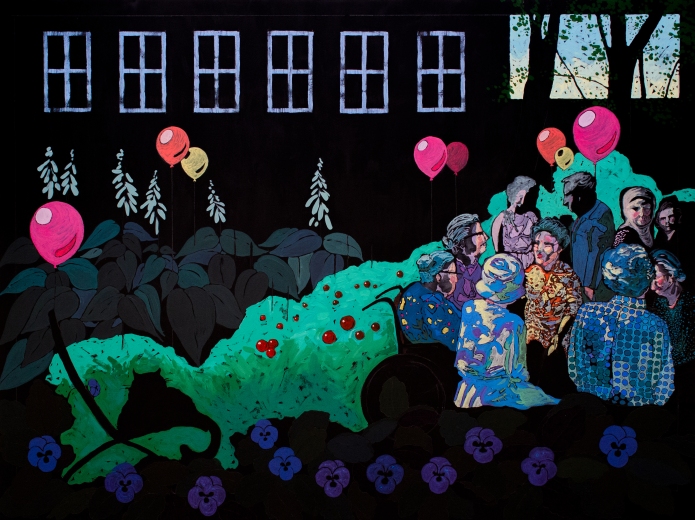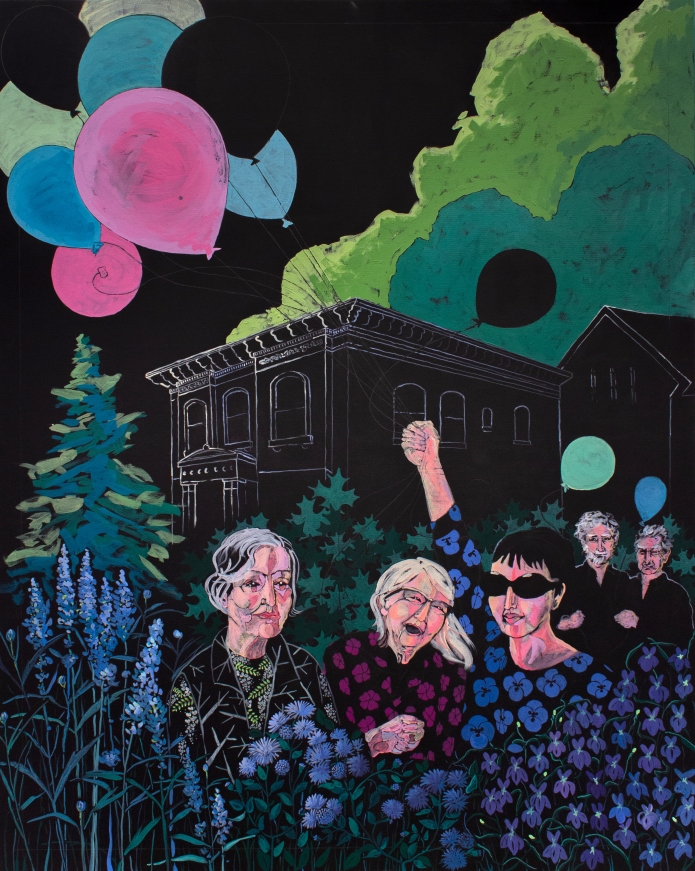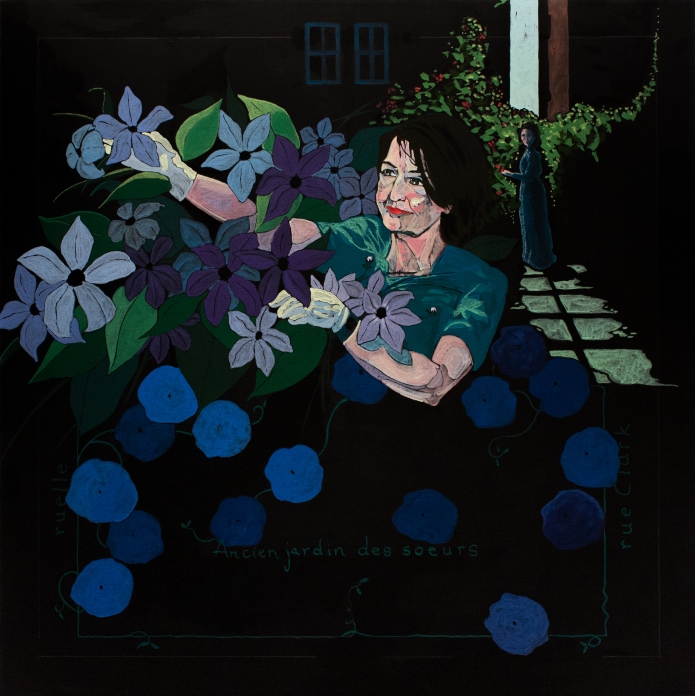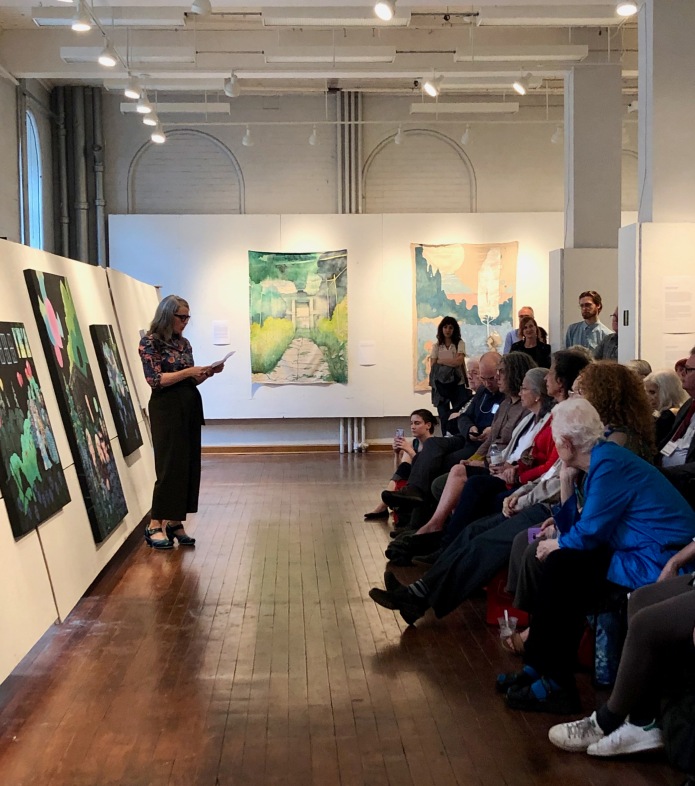In 2019 I was artist in residence at the Association Récréative de Milton-Parc, a community centre located in the heart of the Milton-Parc neighbourhood, which urban activists saved from demolition over the course of a long battle in the 1970s and 80s. The spirit of community organizing remains strong in Milton-Parc today, and includes the care of trees, the creation of green alleyways, and the fight to save the historic Notman Garden, located behind the former home of famed Montreal photographer, William Notman. As artist in residence, I conducted interviews with people who had fought to save this urban landscape, and with people who had planted and cared for the garden while the property was – for many years – a home for elderly women. In addition, my series of paintings responded to archival research in the McCord Museum, the Ville de Montréal archives, and the Drummond Foundation. The Notman Garden series was shown alongside three other series of paintings exploring the relationship between women and gardens in a solo exhibition at the McGill School of Architecture in June 2019.

Exhibition view, Les Jardins des femmes, showing the Notman Garden Series. McGill School of Architecture, June 2019. Photograph: Doug Dumais.
The following excerpt from the exhibition catalogue, Les Jardins des femmes (available here) was written by architectural historian and McGill professor, Annmarie Adams.
This series of paintings by Cynthia Imogen Hammond explores the layered history of a site framed by Sherbrooke Street West, rue Clark, and rue Milton in Montreal. This property has served as a grand residence, a long-term care home, and more recently a technology hub. In the late twentieth century, it became the centre of intense activism and public debate.
The neoclassical house at 51 Sherbrooke Street West, designed by architect John Wells, takes its name from its most famous occupant, the photographer William Notman (1826-1892). After Notman’s death, philanthropist and suffragist Julia Drummond (1860-1942) and George Drummond (1829- 1910) bought the house, adding a rear wing: St Margaret’s Home. Designed by architect Andrew Taylor and opened in 1894 as a home for “incurables,” the ensemble became a care facility and residence primarily for older women in 1920. Taylor also designed the Macdonald-Harrington Building, the location of the Jardins des femmes exhibition.
St Margaret’s Home relocated in 1991, leaving the future of the Notman House, St Margaret’s, and the 150-year old garden uncertain. In the intervening 27 years, Communauté Milton-Parc activists fought to save the house, the former institution, and the garden from development. With regard to the latter, the arguments pointed to the rarity of extant gardens from the city’s Square Mile, as well as the presence of almost fifty species of rare trees, and the paucity of green space in the area. In February 2018, the City of Montreal agreed to expropriate the land to preserve it as a public park. The garden presently sits locked behind a chain-link fence, somewhere between abandon and preservation.
As part of Hammond’s work on gendered landscapes, the Notman Garden series explores the complex and powerful relationships between historic gardens and the women who occupy and care for them. Collectively, the series does not only speak to the rich past of this unique site in Montreal; it also points to the site’s potential re-use as a green space for aging Montrealers. Hammond believes that this special urban landscape should be redesigned as a garden for the elderly – and indeed, this was its purpose for decades. The Notman Garden series reminds us that a garden for the elderly would be a rare and beautiful addition to the quartier Ville-Marie, as well a direct homage to the site’s century of use by older Montrealers.

Our Chosen Kingdom, 2019. Acrylic, acrylic gouache, and pencil on canvas. 24 x 48” Photograph: Doug Dumais.
The title of this work is a fragment of a phase from Julia Drummond’s first official address to the Local Council of Women of Montreal (1894), in which she states, “Home will ever be our chosen kingdom.” As a “home”, St Margaret’s was clearly a place of care for women in the last stages of their lives. The trees depicted in this work would have given much-needed shade and cooling during the summer months, while the flowering trees and bushes would have filled the ward and private rooms with sweet scent and – seen from the windows – beautiful colour.

Three Sisters, 2019. Acrylic gouache and pencil on canvas. 36 x 48” Photograph: Doug Dumais.
In her exhibition catalogue notes, Annmarie Adams observes that, “St Margaret’s Home was run by a sisterhood of Anglican nuns, a rarity in Catholic Montréal. In this work, three Anglican sisters pose behind purple hollyhocks, which were ubiquitous in the garden of St Margaret’s Home.”
When I first visited the Notman Garden in October 2018, it was shaded by a canopy of mature trees, and sheltered on two sides by substantial buildings (the former St Margaret’s Home to the south, and a 14-storey apartment building to the west). With the late fall sunshine illuminating the bright fall foliage all around the garden, I was struck by the quality of light. The garden was darker than its surroundings, but not sombre. On the contrary, the relative darkness brought every leaf, every colour, into relief. I wanted the paintings in this series to echo this rich darkness and vivid colour, which left me with the impression that the garden was illuminated from within.

Shade and Solace (Garden Party), 2019. Acrylic gouache and pencil on canvas. 36 x 48″ Photograph: Doug Dumais.
Adams writes, “The Diggers and Weeders Garden Club of Montreal planted and maintained the landscape surrounding Notman House and St Margaret’s Home for thirty years, until St Margaret’s Home moved to Westmount in 1991.”
An article in the July 16, 1970 edition of the Montreal Star called for volunteers to help bring “old and handicapped patients into the garden to enjoy its shade and solace.” All plants depicted in Shade and Solace were grown in the garden (special thanks to Doreen Lindsay for helping me to identify species from archival photographs). The Diggers and Weeders also brought flowers from their own gardens in Westmount to supplement the plants that they purchased annually to plant on the grounds. Sarah Stevenson, past president of the Diggers and Weeders, recalls how the group assembled little posies of flowers on Valentine’s Day and other holidays, so that the residents should have flowers during the winter as well. Sarah Stevenson told me that the Diggers and Weeders made every effort to plant a “pow” garden: flowers that would be bright and smell sweet, so that older residents could see and enjoy them.

Patrimoine vivant, 2019. Acrylic gouache and pencil on canvas. 48 x 60” Photograph: Doug Dumais.
Adams writes, “The entire site – Notman House, St Margaret’s Home, and the adjacent garden – was the focus of intense activism for about two decades. Residents of Milton-Parc focused their attention on the future of the garden once the preservation of the house was secured. For the activists, the trees were just as important as the buildings. The term “living heritage”, a phrase used by several activists involved in the effort to preserve the garden, captures the all-important inclusion of trees and plants as historic property. All the plants depicted in this painting grew or were planted in the garden: (left to right) white pine, salvia, honey locust, ageratum, impatiens, pansies, lobelia, and silver maple.”
This painting, the largest in the Notman Garden series, collapses various chapters in the history of local activism and organizing. In the foreground on the left is Anne-Marie Boucher, one of the most important figures in the effort to save the garden, pictured today. On the far right in the foreground is Colette Quesnel, who was frequently interviewed and photographed during the fight to save Notman House, pictured in 2001. Towards the rear, to the right, are James Dormeyer and Tony Antakly, who were very involved in the work of preserving the garden. And in the centre foreground is Lucia Kowaluk (1935-2019), one of Milton-Parc’s best-known activists, who fought for the preservation of the neighbourhood and the residents’ right to the city for over five decades.

Une militante improvisée, 2019. Acrylic gouache and pencil on canvas. 36 x 36” Photograph: Doug Dumais. (Private collection.)
Anne-Marie Boucher describes herself as a “militante improvisée” with regard to the work of saving the Notman Garden, with which she was heavily involved up until 2015. The hastily-drawn plan that partially inspired this painting was among her papers, which deposited to the Montreal archives in 2013. Drawn as part of a property assessment in 2001, the plan does not communicate the biodiversity or the intangible heritage of this landscape. But its hastily-drawn trees, reminiscent of blooms, inadvertently spoke to the long history of flower tending and cultivation in this space. In this work I wanted to show how the passionate political involvement of one woman, in this case Boucher, could be linked to something as simple as caring for flowers and trees.

The Last Tulip, 2019. Acrylic gouache and pencil on canvas. 8 x 12″ Photograph: Doug Dumais. (Private collection.)
I undertook most of the work on the Notman Garden series from January through to May 2019, and was lucky to be working in close proximity to the garden itself. Spring came very late this year, after a long and bitterly cold winter. On one of my visits in May, the garden had started to green again. And in the middle, was one beautiful red tulip. Undoubtedly a trace of the many years in which the Diggers and Weeders had sought to bring colour, scent, and beauty to the residents of St Margaret’s Home.

Hammond’s artist talk, 20 June 2019, School of Architecture at McGill University (as part of the conference, Crossing Boundaries and Constructing Linkages). Photograph: Isha Levy.
Acknowledgements
This project would not have been possible without the support and collaboration of many people. I am first and foremost deeply grateful to Dr Annmarie Adams, who contributed to the exhibition catalogue, for engaging in this and other collaborations with me. I am also grateful for the support of the Gail and Stephen A. Jarislowsky Institute for Canadian Art Studies, and the Peter Guo-hua Fu School of Architecture of McGill University, for supporting this exhibition. I want to thank the Association Récréative de Milton-Parc for the warm welcome during my residency, and all the individuals who shared memories, knowledge, or gave help in some way to my project: Helen Angelopoulos, Tony Antakly, Anne-Marie Boucher, Haley Jenkins-Crumb, the Drummond Foundation, William Fong, Samantha Leger, Doreen Lindsey, Kate Marley, Nathan McDonnell, Bruce McNiven, Sarah Stevenson, and especially Doug Dumais and Jason Levy.
As the creator of this project, I acknowledge that my work took place on unceded Indigenous territory. I recognize with gratitude the Kanien’kehá:ka Nation as the custodians of the lands upon which my research and paintings emerged. These are the same lands upon which the Notman Garden was planted, tended, enjoyed, abandoned and, at last, protected.